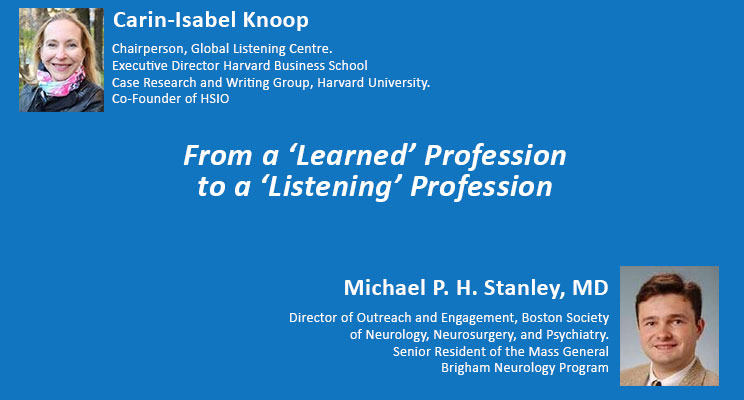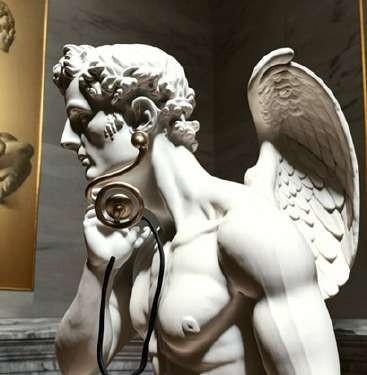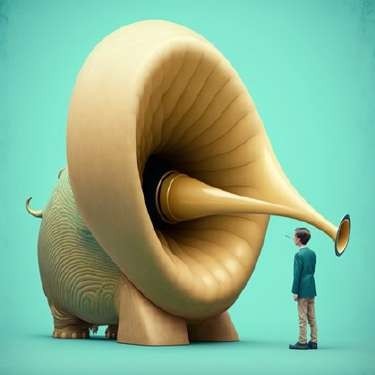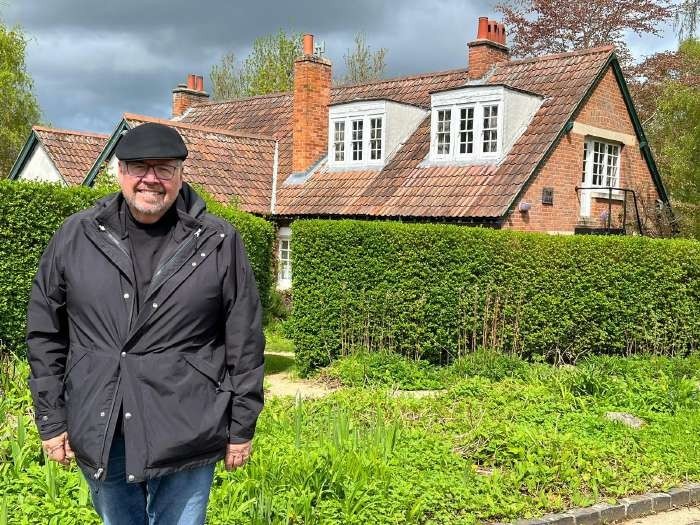
From a ‘Learned’ Profession to a ‘Listening’ Profession
Carin-Isabel Knoop
Chairperson, Global Listening Centre.
Executive Director Harvard Business School
Case Research and Writing Group, Harvard University.
Co-Founder of HSIO
Michael P. H. Stanley, MD
Director of Outreach and Engagement, Boston Society
of Neurology, Neurosurgery, and Psychiatry.
Senior Resident of the Mass General
Brigham Neurology Program
As children, we are often just told to but never taught how to listen. Some of the only instruction we’ll ever receive on how to listen is when learning our profession.
What differentiates expertise from unawareness is the basis of knowledge, but of equal importance is structuring present problems with which to apply that knowledge. A person might say the exact same words, but they are heard differently by a lawyer, a doctor, or a priest because these learned professionals have internalized very different positions on listening.

Auscultation
(photo credit Antonio Sadaric and midjourney;
prompt: a statue of a large ear with a stethoscope
in a museum, in the style of Michelangelo)
Some might discard elements from what they heard, others might reframe what they heard into their own narrative, and a third might take what they heard as sufficient information for their purposes. Those purposes are generally explicit (one seeks a doctor for their physical care, a lawyer for their legal counsel, and a priest for their spiritual direction). However, even within those explicit purposes are numerous and shifting objectives, often negotiating the con- versation with the patient/client/ parishioner and managing the meeting’s boundaries and goals – all guided by leadership through listening.
The authors, one a cognitive behavioral neurologist, and the other a management researcher and higher education leader, have begun to explore the axes upon which different professions construct their approach to listening “on the job,” as it were, and organize the shared principles as:
- a) What is the listener listening to (the nature or purpose of the messages and the speaker’s intentions)
- b) What is the listener listening for (the component elements of the message itself)?
- c) Where is the listener listening from (the personal processes that may inform and filter the incoming information)?
Using a medical conversation as an example, we aim to show that the listener should be conscious of the nature of their own intentions and the speaker’s intention for the meeting. This sets the context to correctly identify the infinite array of information contained within the speaker’s words for the listener to pay attention to. Why the listener is paying attention will determine how and what one is paying attention to. Being intentional about why, what, and how will help you check yourself for inattentions and distortions in what you think you heard.
The Medical Conversation
In a medical consultation, there are specific forms of listening that follow parameters. Doctors ‘take’ histories; patients do not ‘give’ them. The pejorative often seen in charts that a patient was ‘a poor historian’ is as foolish as it is seeks to absolve the doctor from responsibility. Patients chronicle their experiences. It is the doctor who plays the historian. Shifting the burden of communication on to the patient/speaker fundamentally leads to misinterpretation of the active and intentional process of a doctor’s listening.
Taking the History of Present Illness
The goal of listening to the patient is to extract from an account of his symptoms the non-accidental elements of an illness’s course and render its elements into a diagnosis that conforms with a synthetic category called ‘disease.’ This hypothesized disease is then explored with confirmatory tests to uncover a specific pathology. If both patient and the doctor are lucky, we can treat the pathology from which the disease arrives, ultimately relieving the patient’s suffering.
The goal of listening is to delineate the patient’s understanding of their illness, its source, its effect on his life, and its therapeutic options (an ecological view of illness) given that these elements will organize the therapeutic approach. Depending on the patient’s appreciation of the situation, this may determine what strategy is plausible.
The doctor is listening to the patient but also listening to self. Based on that self-monitoring, the doctor can permute the formula of questions to redirect the inquiry.
Sometimes the inquiry can be reshaped to be more explicit or specific (e.g., yes/no answers only, leading questions), or purposely vague (open-ended questions to reduce influencing the response, or tangential questions to minimize the chance the patient can anticipate where the inquiry is pointing to). Sometimes this diagnostic inquiry can be paused to utilize an appreciative form of listening (not less active, to be therapeutic rather than diagnostic).
All conversations have a structure, but we’re often not consciously considering how aligned the intents, objectives, and methods of the speaker and the listener are to the underlying structure. The doctor might follow one of the mnemonics in medicine, such as ‘Oldcarts,’ to ensure he/she doesn’t forget any steps.

Signs, symptoms, and stethoscopes
(photo credit Antonio Sadaric and midjourney;
prompt: “a large ear in the size of a human,
listening to a conversation with a stethoscope,
in the style of Wes Anderson”)
Using this device implies a formal structure to a doctor’s listening, and that structure enables a function (diagnosis). The patient’s autobio-graphical history may not align with that structure, and the doctor will reorganize the sequence in her head.
The patient is listening to the doctor and self. He adjusts what he says in response to the perceived connotations and implications of the doc[1]tor’s questions. Sometimes, he dis[1]covers a previously unacknowledged feature of his experience while listening to himself. Other realizations come from this new selfdiscovery. Through speaking and listening, the history of the present illness is defined. This narrative is then written up in a special script encoded with actionable information, in the form of clinical notes.
The history of present illness will relay the symptoms shared by the patient. Symptoms are sensations or feelings reported by the patient. The symptom is what a patient says: “I have a headache.” What the doctor sees are signs — observable characteristics. In this instance, “the patient presents with a nail sticking in her head.”
Both have their own goals in the interaction. A doctor wants to find a problem or get the patient out of their office/appointment efficiently. The patient might have a primary reason for coming in to be seen but is also working toward a secondary gain — perhaps a note from the doctor to get out of jury duty . So the physician might also be listening for what else her interlocutor might seek.
As we saw, the doctor uses an approach generally for a consultation and carefully distinguishes between what is said and observed. This is not just letting one’s client talk. It’s using your response to signal that their appreciation of the situation is being appreciated in turn by the consultant. Being listened to is being known, which goes a long way toward developing an alliance with the patient.
This approach is relevant to any consultant approaching a client’s question. Consultation can be loosely defined. A supervisor listening to the concern of a subordinate or a junior colleague trying to understand the demands of a senior manager can and does use some of a consultative approach. When listening for anything other than pleasure, one should listen with intention and structure. Mort Adler’s classic, “How to Speak, How to Listen” provides a general set of rules that can be a useful structure for anyone engaged in a productive, transactional dialogue (of which a consultation is a form).
The listener should be conscious of the nature of the intention, as why one is paying attention will determine how one pays attention and to what one is paying attention to. The listener should be conscious of the structure of reception and interpretation of the speaker’s response. A doctor’s structure is different than an attorney’s, a pastor’s, and an architect’s etc., but each has a structure, and they deploy that structure in listening like a filter. The key is to ensure that the listener’s sieve is set to the right grain for the speaker’s purposes so that both catch what they need in the interaction to act on this information.
Listening with a Third Ear
In the 1940s, psychoanalyst Theodor Reik wrote a book by the title “title of the book”. A family institute describes this ear as being able to hear beyond the surface words to the underpinning emotions: “With our Third Ear we’re like an audience listening while staying in our seats, never climbing onto the stage to join the drama.”
Do different occupations listen differently, and in what ways? Occupations, by their nature, have specified outputs, whether a good or a service, and the ways someone functions as a Listener during career-context communication, in turn, might influence what they are listening to and listening for. In other words, a butcher, a baker, and a candlestick-maker might have different strategies for Listening. Whether or not you yourself, are a butcher, baker, or a candlestick-maker, their strategies might prove an adaptable strategy suited to your needs. How would knowledge of these occupational listening strategies circumvent or resolve cognitive traps?
When you have a chance to interact with a professional, consider the parameters of “listening to, for, and from” across disciplines, professions, careers (an athletic coach and a professional coach; a politician and a school[1]teacher), but also in those occupational roles that inter[1]play (a doctor, a nurse, and a patient; a 911 dispatcher and a policeman; musicians and conductors).
Ask what also impedes their performance as listener. These range from expediency (for a doctor, it might be to get to a diagnosis and send the patient along or for a DA to get a protective order) and dopamine (from the reward of having “solved a problem” and checked off a box), to the traps of assumptions (“patients always lie”), distraction (and the siren songs of the cell phone), and self-deprecation (listening to the voices about ourselves in our heads, “management does not understand me” or “my patients don’t respect me because I look so young”).
In leadership positions, we are often handed a bullhorn, when what we should reach for is an ear-horn. Those who lead from a position of listening—as is natural in the professions like pastors, attorneys, and physicians— do so because the scope of their practice seemingly makes clear why their parishioner, client, or patient has arrived. However, sometimes the care a patient needs is pastoral, not medical.
Recognizing one’s own premise and pattern for listening is the first step in learning to tune your ear to the registers of different professional pitches so that powerfully but paradoxically when the speaker listens to your response, it is they who feel heard.
Authors (inspired by many others including coach Sylvie Maury, storytelling researcher Antonio Sadaric, PhD, mediators Eugene Kogan, PhD, and psychiatrist Doctor Daven Morrison)
Michael P. H. Stanley, MD, is a neurology fellow, Brigham and Women’s Hospital. He currently serves as the director of outreach and engagement for the Boston Society of Neurology, Neurosurgery, and Psychiatry, as well as the director of the Young Oslerian Group within the American Osler Society. In addition to his clinical duties, he is a frequent contributor of essays and articles on the intersection of medicine and society, writing for the Wall Street Journal, National Review, and Portland Press Herald, among others. Follow him @Mphstanley on Twitter.
Carin-Isabel Knoop founded and leads the 20-member case writing team at Harvard Business School. Learning about managers’ challenges pushed her to improve their lives, which led to the publication of Compassionate Management of Mental Health at Work with Professor John A. Quelch (Springer, 2018). She also co-founded HSIO (Human Sustainability Inside Out), a provider of mental health support materials and educational programs, and speaks and publishes about mental health in the U.S., French, and Spanish-language spheres. She enjoys soft-serve ice cream, pragmatic idealists, and postcard writing.

